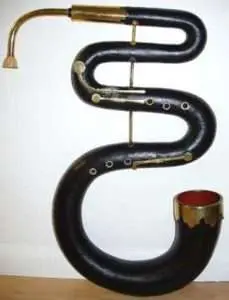
How to choose a bass guitar
Contents
A bass guitar (also called an electric bass guitar or just a bass) is a string- plucked musical instrument designed to play in the bass range e. It is played mainly with fingers, but playing with a mediator is also acceptable ( a thin plate with a pointed end , which cause strings to vibrate ) .
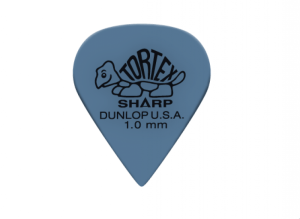
Mediator
The bass guitar is a subspecies of the double bass, but has a less massive body and neck , as well as a smaller scale. Basically, the bass guitar uses 4 strings , but there are options with more. As with electric guitars, bass guitars require an amp to play.
Before the invention of the bass guitar, the double bass was the main bass instrument. This instrument, along with its advantages, also had a number of characteristic drawbacks that made it difficult to widely use it in popular music ensembles of the early 20th century. The disadvantages of the double bass include large size, large mass, vertical floor design, lack of frets on the fretboard , short sustain , a relatively low volume level, as well as a rather difficult recording, due to the characteristics of the dynamic range a.
In 1951, American inventor and entrepreneur Leo Fender, the founder of Fender, released the Fender Precision Bass, based on his Telecaster electric guitar.

Leo Fender
The instrument gained recognition and quickly gained popularity. The ideas embodied in its design became the de facto standard for bass guitar manufacturers, and the expression “bass fender” for a long time became synonymous with bass guitars in general. Later, in 1960, Fender released another, improved bass guitar model – Fender Jazz Basswhose popularity is not inferior to the Precision Bass.
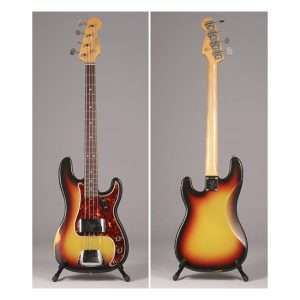 Fender Precision Bass |  Fender Jazz Bass |
Bass guitar construction

1. Pegs (peg mechanism ) are special devices that regulate the tension of the strings on stringed instruments, and, first of all, are responsible for their tuning like nothing else. Pegs are a must-have device on any stringed instrument.

Bass guitar heads
2. Nut – a detail of stringed instruments (bowed and some plucked instruments) that raises the string above the fingerboard to the required height.
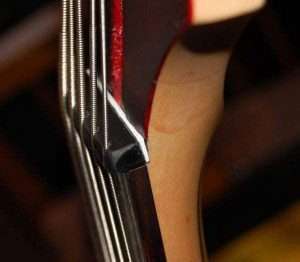
Bass nut
3. Anchor – a curved steel rod with a diameter of 5 mm (sometimes 6 mm) located inside the neck of a bass guitar, at one end of which there must be an anchor nut. The purpose of the anchor a is to prevent the deformation of the neck a from the load created by the tension of the strings, i.e. the strings tend to bend the neck , and the truss tends to straighten it.
4. Frets are parts located along the entire length of the guitar neck , which are protruding transverse metal strips that serve to change the sound and change the note. Also fret is the distance between these two parts.
5. Fretboard – an elongated wooden part, to which the strings are pressed during the game to change the note.

Bass neck
6. Deca – the flat side of the body of a stringed musical instrument, which serves to amplify the sound.
7. A pickup is a device that converts string vibrations into an electrical signal and transmits it via cable to an amplifier.
8. String holder (for guitars it can be called ” bridge “ ) – a part on the body of stringed musical instruments to which the strings are attached. The opposite ends of the strings are held and stretched with the help of pegs.
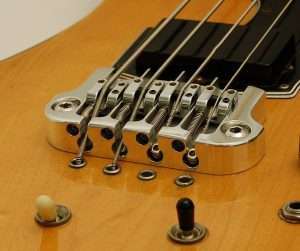
Tailpiece ( bridge ) bass guitar
Important tips for choosing a bass guitar
The experts of the store “Student” will tell you about the main steps when choosing a bass guitar and how to choose the one that you need, and not overpay at the same time. So that you can better express yourself and communicate with music.
1. First, listen to how the individual strings sound without connecting the guitar to the amplifier. Place your right hand on the deck and pluck the string. You should feel the vibration of the case! Pull the string harder. Listen to how long the sound lasts before it fades out completely. This is called sustain , and the more it is , the better the bass guitar.
2. Inspect the bass guitar for defects in the body, this item includes smooth painting, without bubbles, chips, drips and other visible damage;
3. See if all the elements, for example, such as the neck , are fastened well, if they hang out . Pay attention to the bolts – they must be screwed in well;
4. Be sure to check the neck , it must be smooth, without various irregularities, bulges and deflections.
5. Most modern instrument manufacturers use the traditional 34″ (863.6mm) Fender scale, which is comfortable enough for many players. Shorter scaled basses suffer from the tone and sustain of the instrument, but are much more comfortable for shorter players or children/teenagers.
A great example of a successful and good sounding short scale bass is the 30″ Fender Mustang.
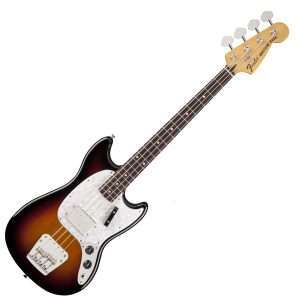
fender mustang
6. Run your finger along the edge of the lining, nothing should stick out and scratch from it.
7. Play should be comfortable! This is the basic rule and it doesn’t matter which neck you choose the bass guitar with: thin, round, flat or wide. It’s just your neck .
8. Choose a four-string bass to start with. This is more than enough to play 95% of the world’s existing musical compositions.
Fretless bass guitar
Fretless basses have a special sound because, due to the lack of frets , the string has to be pressed directly against the fretboard wood. The string, touching the fretboard a, makes a rattling sound, reminiscent of the sound of a double bass. Although the fretless bass is often used in jazz and its varieties, it is also played by other types of musicians.

Fretless bass guitar
A fretted bass guitar is more suitable for a beginner . Fretless basses require precise playing and good hearing. For a beginner, the presence of frets will make it possible to play notes most accurately. When you have more experience, you will be able to play a fretless instrument, usually a fretless bass is bought as a second instrument.
Playing fretless bass guitar
Attaching the neck to the deck
The neck is attached with screws.
The main type of fastening the neck to the deck is screw fastening. The number of bolts may vary. The main thing is that they keep it well. Bolt-on necks are said to shorten the duration of notes, but some of the best bass guitars, the Fender Jazz Bass, have just such a mounting system.


Neck on screws
Through neck .
“Through neck ” means that it goes through the entire guitar, and the body consists of two halves that are attached to the side. These necks have a warmer sound and longer sustain . The strings are attached to one piece of wood. On these guitars, it is easy to clamp the first frets . These basses are usually more expensive. The main disadvantage is the more complicated setting of the anchor .


Through neck
Set -in neck
This is a compromise between screw-mount and through-mount, while retaining the benefits of each.
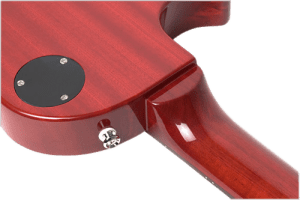

Glued neck
A tight connection between the neck and the body of the bass guitar is extremely important , because otherwise the vibration of the strings will not be transmitted well to the body. Moreover, if the connection is loose, the bass guitar can simply stop keeping the system. Neck- thru models have a softer tone and longer sustain , while bolt-on basses sound more rigid. On some models, the neck is attached with 6 bolts (instead of the usual 3 or 4)
Active and passive electronics
The presence of active electronics means that the bass guitar has a built-in amplifier. Usually he needs additional power, which gives him a battery. The advantages of active electronics are a stronger signal and more sound settings. Such basses have a separate equalizer to adjust the sound of the guitar.
Passive electronics do not have any additional power source, sound settings are reduced to volume, sound tone and switching between pickups (if there are two). The advantages of such a bass are that the battery will not run out in the middle of a concert, in the simplicity of sound tuning and traditional sound , active basses give a more aggressive, modern sound.
How to choose a bass guitar
Bass guitar examples
  PHIL PRO ML-JB10 |   CORT GB-JB-2T |
  CORT C4H | 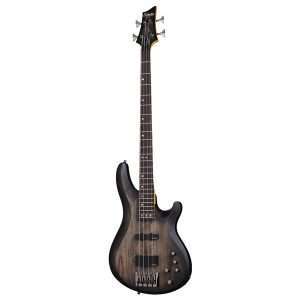  SCHECTER C-4 CUSTOM |




